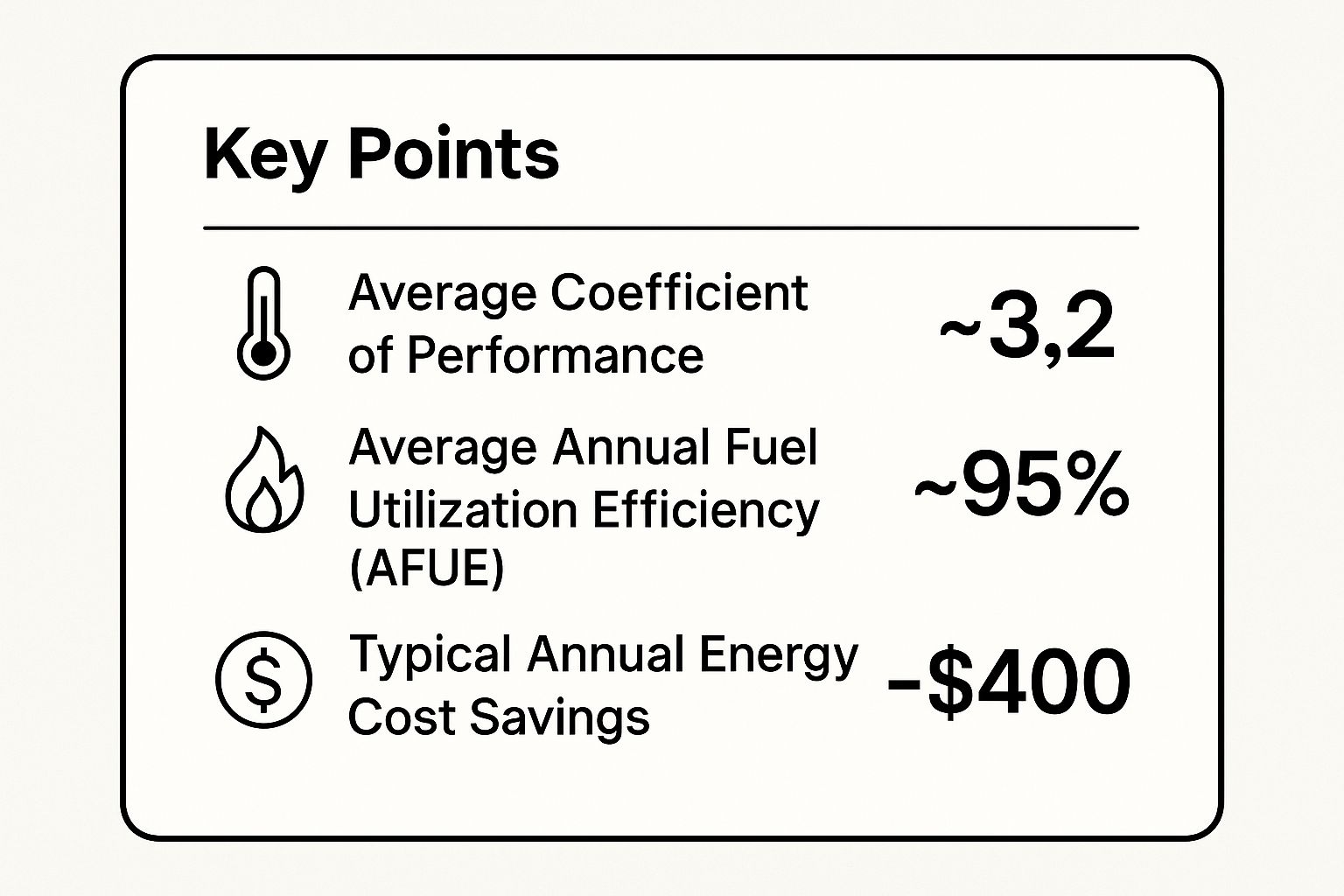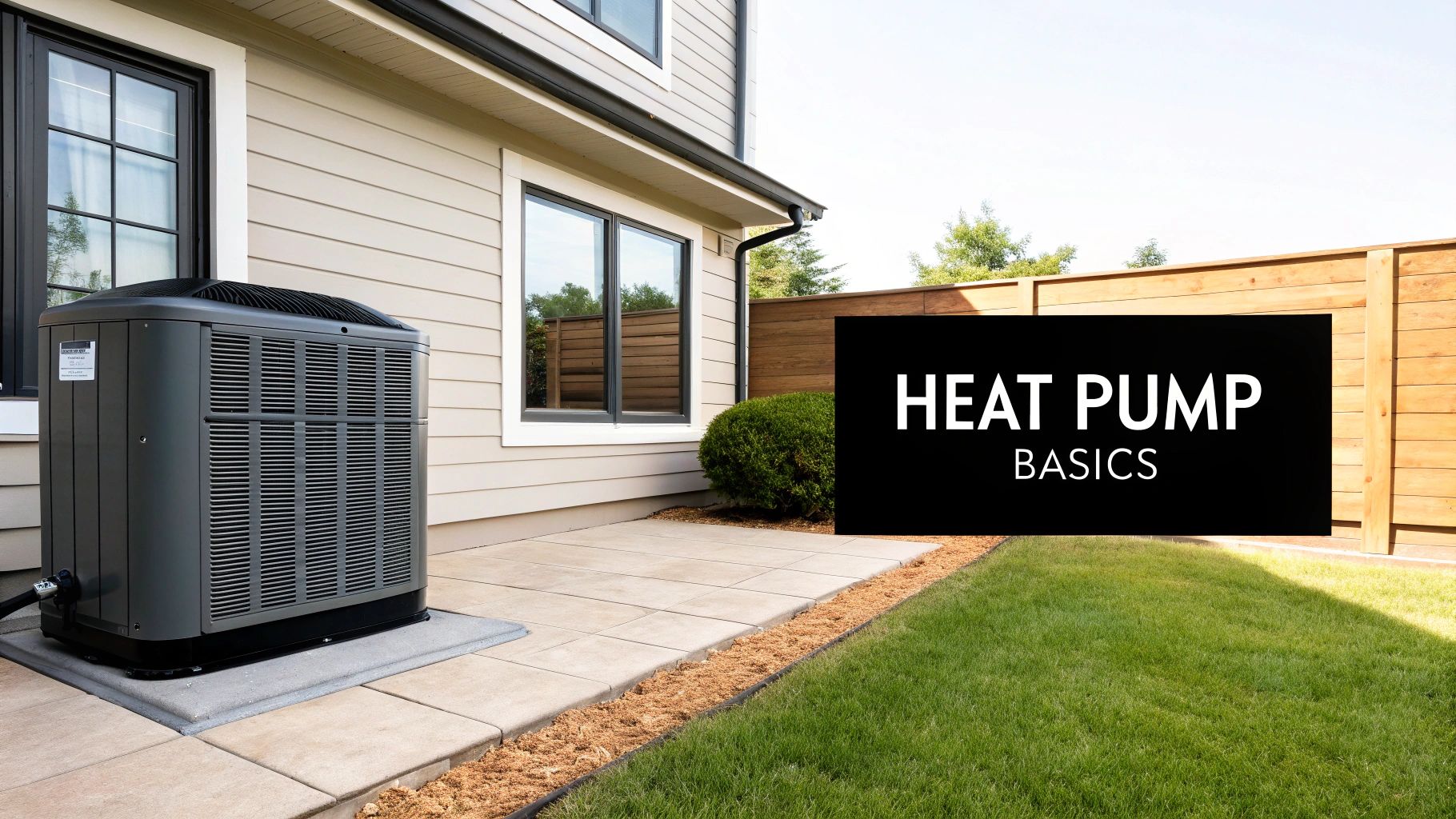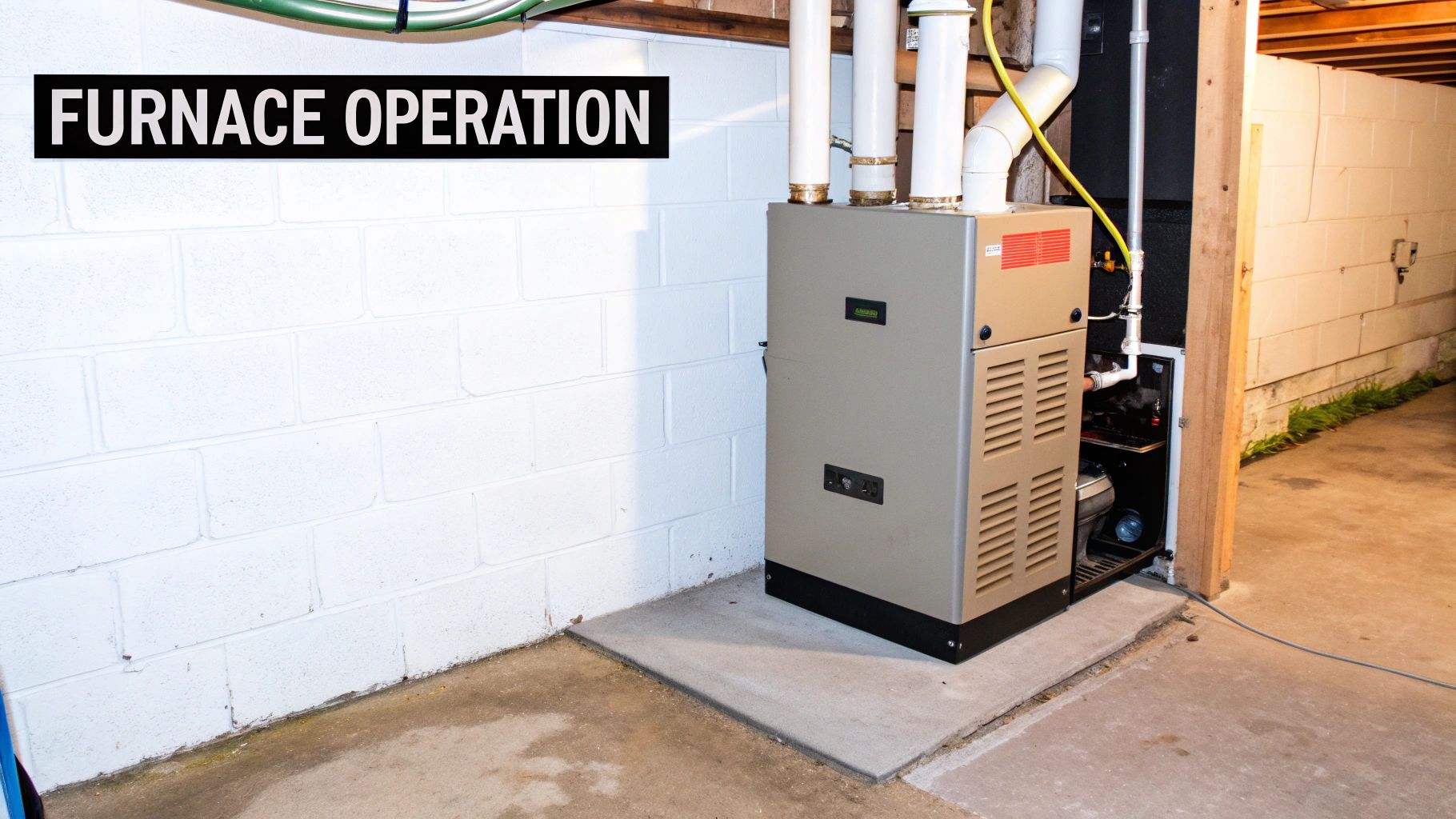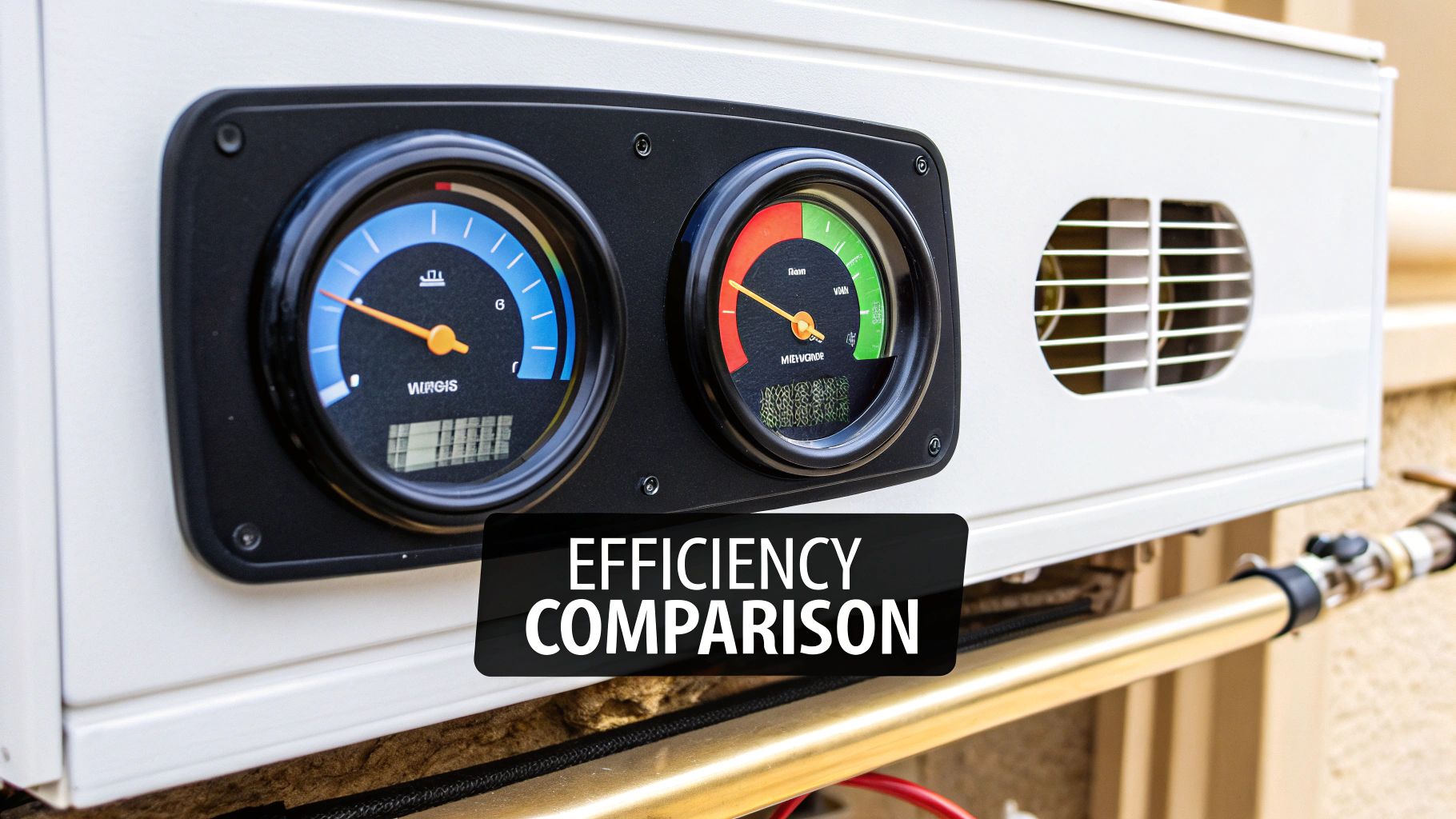Heat Pump vs Furnace An Arizona Homeowner's Guide
- shawncovenantaire
- 23 hours ago
- 14 min read
When it comes to choosing between a heat pump vs furnace, most Arizona homeowners find one clear frontrunner. Our climate demands both reliable cooling in the summer and efficient heating in the winter, so the system you pick affects your comfort, and your energy bills. The Definitive Answer For Arizona Homes

The Definitive Answer For Arizona Homes
In Arizona’s climate, the lines between heating and cooling blur. Summers can top 110°F, winters rarely dip below freezing, and that means your HVAC choice must excel in both modes.
A heat pump handles that challenge with ease. It replaces your furnace and air conditioner in a single unit, cycling seamlessly from heating to cooling.
Key Advantages Of Heat Pumps:
Dual Functionality: One system for both heating and cooling
Heat Transfer Efficiency: Moves existing heat instead of generating it
Year-Round Savings: Optimized energy use in mild winters and blistering summers
“A heat pump’s two-in-one design streamlines your home’s mechanical systems and cuts energy consumption all year—a huge benefit in Arizona.”
This infographic breaks down the core efficiency and savings data for a quick comparison.

The numbers speak for themselves: by moving heat rather than creating it, a heat pump achieves far greater efficiency than a furnace, translating into substantial annual savings.
Quick Comparison Heat Pump vs Furnace At A Glance
Quick Comparison Heat Pump vs Furnace At A Glance
Below is a concise overview to help you decide at a glance:
Feature | Heat Pump | Gas Furnace |
|---|---|---|
Function | Heats and cools (all-in-one) | Heats only |
Energy Source | Electricity | Natural Gas or Propane |
Best Climate | Mild to hot climates | Cold to very cold climates |
Energy Efficiency | Extremely high (moves heat) | High (creates heat) |
As you can see, heat pumps excel in our local conditions—offering both heating and cooling without the need for separate systems.
Nationwide Trends Reflect Arizona’s RealityHeat pump shipments have overtaken gas furnaces since late 2021, with 4.1 million units shipped last year compared to 3.1 million furnaces. That surge underscores a growing preference for efficient, flexible comfort solutions—exactly what Arizona homes need.
How Each System Actually Heats Your Home
To make the right call in the heat pump vs. furnace debate, you first have to understand how they actually get the job done. Sure, both systems deliver warm air into your home, but their methods couldn't be more different. Those differences are what lead to huge variations in energy efficiency and what you’ll see on your monthly utility bills.

It all boils down to one simple concept: one system moves existing heat, while the other has to create it from scratch. This single distinction is the secret behind their vastly different energy profiles and why one is often a better fit for Arizona’s climate.
The Furnace: Creating Heat with Combustion
A furnace is pretty straightforward—it makes heat through a process called combustion. When your thermostat calls for warmth, a gas furnace ignites a controlled flame, usually with natural gas as its fuel source. This fire heats up a critical metal component known as a heat exchanger.
As your HVAC system's blower fan kicks on, it pushes indoor air across that superheated exchanger, warming it up almost instantly. From there, the newly heated air travels through your ductwork to warm your home. It’s an effective and time-tested method that produces intense heat quickly, but it’s entirely dependent on burning fuel to generate every single degree of warmth.
The Heat Pump: Moving Heat with a Refrigeration Cycle
A heat pump, on the other hand, is a bit more clever. It works like an air conditioner running in reverse, using a refrigeration cycle to transfer warmth instead of creating it. It doesn’t burn any fuel. Instead, it pulls existing heat energy from the outside air and moves it indoors.
Even on a chilly Arizona winter day, there’s still plenty of ambient heat in the air. A heat pump’s outdoor unit absorbs this heat into a specialized refrigerant. That refrigerant is then compressed, which dramatically raises its temperature. This hot refrigerant flows to the indoor coil, where the system’s fan blows air across it, warming your home before the air is distributed through your ducts.
The most crucial takeaway is that heat pumps don't generate heat—they relocate it. This process of heat transfer is dramatically more energy-efficient than creating heat through combustion, especially in a mild winter climate.
This smart technology is what allows a heat pump to pull double duty as both a heater and an air conditioner. In the summer, the cycle simply flips, pulling heat from inside your home and dumping it outdoors. Many homeowners who understand this all-in-one functionality see the clear benefits when considering a heat pump replacement for an older, less efficient unit.
Analyzing Real-World Operating Costs and Efficiency
Technical ratings on a sticker are one thing, but what those numbers mean for your wallet is what really matters. When you're looking at a new HVAC system, you're not just buying a piece of machinery; you're buying years of future energy bills. This is where the efficiency gap between heat pumps and furnaces becomes impossible to ignore.

For a gas furnace, the metric to know is Annual Fuel Utilization Efficiency (AFUE). This percentage tells you how much of the fuel burned actually turns into usable heat for your home. A modern, high-efficiency furnace might boast a 95% to 98% AFUE rating, which sounds great. But it also means that for every dollar you spend on natural gas, up to 5 cents is literally going up in smoke as exhaust.
Heat pumps play by a different set of rules because they work on a completely different principle. Their cooling power is rated by SEER2 (Seasonal Energy Efficiency Ratio 2), while their heating performance is measured by HSPF2 (Heating Seasonal Performance Factor 2). These ratings tell you how much heating or cooling you get for each unit of electricity you pay for.
The Efficiency Gap Explained
Here's the mind-blowing part. Because heat pumps move heat instead of creating it from scratch, their efficiency can be off the charts. It's not uncommon for a modern heat pump to achieve an efficiency rating of over 300%. That means for every one unit of electricity it uses, it can pump more than three units of heat into your house. A furnace, with its 98% AFUE rating, can never give you more heat than the fuel it consumes.
The core idea is simple: transferring existing heat is fundamentally easier and cheaper than generating new heat through combustion. This gives heat pumps a huge advantage in operating costs, especially in a climate like Arizona's where our heating needs are fairly moderate.
This incredible efficiency translates directly into lower monthly utility bills, making the slightly higher upfront cost of a heat pump a very smart long-term investment for most homeowners here.
Real-World Cost Scenarios in Arizona
Let's ground this in reality by looking at how these systems would perform in different parts of our state. We’ll compare a high-efficiency heat pump to a high-efficiency gas furnace, keeping local utility rates in mind.
Scenario 1: A Home in Phoenix
In a climate like Phoenix where winters are mild, a heat pump is in its element. It almost never sees temperatures cold enough to really challenge its performance.
Heat Pump: Sips electricity for heating thanks to its high efficiency. It's also your primary AC in the summer, making it a powerful all-in-one package.
Gas Furnace: Uses very little natural gas in the winter, which is good. But it requires a completely separate, energy-hungry central air conditioner to battle our brutal summers.
When you look at the entire year, the heat pump's all-in-one efficiency almost always leads to significant savings in the Valley.
Scenario 2: A Home in Flagstaff
Up in Flagstaff's colder, high-altitude climate, the math gets a little more interesting. When temperatures drop well below freezing, a standard heat pump loses some of its efficiency and might need to use its supplemental heat strips, which are not as efficient.
Heat Pump: Still incredibly efficient on milder days but has to work harder on the coldest nights, which will bump up electricity costs.
Gas Furnace: Delivers a powerful, steady blast of heat no matter how cold it gets outside, making it a very reliable choice for severe cold.
Even in Flagstaff, a modern cold-climate heat pump can hold its own and often still comes out ahead. For homeowners looking to squeeze every bit of value out of their system, checking out our guide on how to save on your heating bill with real strategies offers some great tips that work for any system.
Ultimately, the choice comes down to weighing the incredible efficiency of heat transfer against the raw, unyielding power of combustion—and matching that to your specific corner of Arizona.
Comparing Upfront Investment and Long-Term Value
Any smart homeowner knows an investment goes way beyond the initial price tag. When you're weighing a heat pump against a traditional furnace, it's easy to get stuck on the installation cost. But the real story unfolds when you look at the total cost of ownership over the system's entire life. That’s where you find the true value.
At first glance, a heat pump installation often looks more expensive than a gas furnace. That's because it's a more advanced, two-in-one system, handling both your heating and cooling needs. A furnace, on the other hand, just does the heating, which means you still need a separate air conditioner to survive our Arizona summers.
Breaking Down the Initial Costs
For an Arizona home, a new gas furnace might seem like the cheaper option upfront. But remember, that price tag is just for the heater. You still have to buy and install an air conditioner, which is non-negotiable in our climate. When you add the costs of both a furnace and an AC unit, the total can easily match, or even surpass, the cost of a single, high-efficiency heat pump.
There can also be other little costs to consider. A heat pump might need a few electrical upgrades to support it, while a new furnace could require some adjustments to your gas line. These factors will nudge the final price one way or the other, so always get a detailed quote that spells everything out. If you're leaning toward a furnace, understanding the full gas furnace replacement process is a great place to start.
Think of it this way: a heat pump's higher sticker price is an investment in a single, unified system. Instead of buying two separate machines for your home, you're getting one highly efficient unit that does both jobs—and saves you more money all year long.
Projecting the 15-Year Total Cost of Ownership
To really see which system wins financially, we need to zoom out and look at the total cost over a typical 15-year lifespan. This includes the initial purchase, all those future energy bills, and routine maintenance. The worldwide trend toward heat pumps says a lot about their long-term value; the market was recently valued at USD 86.5 billion and is expected to hit USD 148 billion by 2030, all thanks to its incredible efficiency. You can see the full market analysis over on Grand View Research.
So, what does this look like for a typical Arizona homeowner? Let’s break it down.
15-Year Total Cost of Ownership Projection
Here's a projection comparing the total cost of installing and running each system over 15 years in a standard Arizona home. This gives you a much clearer picture of your long-term financial commitment.
Cost Component | Heat Pump (Average) | Gas Furnace (Average) |
|---|---|---|
Installation Cost | ~$9,000 – $15,000 | ~$8,000 – $14,000 |
Annual Energy Cost | ~$1,200 | ~$1,650 |
15-Year Energy Total | ~$18,000 | ~$24,750 |
15-Year Maintenance | ~$2,250 | ~$2,250 |
Total 15-Year Cost | ~$29,250 – $35,250 | ~$35,000 – $41,000 |
Note: These are just estimates. Your actual costs will vary based on your home's size, the system's efficiency rating, and local utility rates.
As you can see, even though the upfront costs are in the same ballpark, the massive energy savings from a heat pump make it the clear winner over the long haul. That difference adds up to thousands of dollars back in your pocket.
Unlocking Incentives and Rebates
Here's the real game-changer: financial incentives. To encourage homeowners to make energy-efficient choices, there are some incredible programs available for those who install high-efficiency heat pumps.
These benefits can slash your initial out-of-pocket cost:
Federal Tax Credits: The government is offering significant tax credits that can save you thousands on a qualifying heat pump installation.
Local Utility Rebates: Arizona utility providers like Tucson Electric Power (TEP) often give direct rebates to customers who install energy-efficient heat pumps.
These incentives are almost exclusively for heat pumps—you won't find them for standard gas furnaces. When you take advantage of these programs, you can dramatically lower the upfront cost, making the heat pump the more affordable choice from day one and supercharging your long-term savings.
Matching Your System to Your Arizona Climate Zone

Arizona's geography is anything but uniform, so a one-size-fits-all approach to your home's comfort just won't cut it. The right answer in the heat pump vs. furnace debate comes down entirely to where you live—from the sun-scorched deserts around Yuma to the snowy peaks near Flagstaff. Getting this right is the key to making a smart, long-term investment in your comfort.
For most of the state, the choice is pretty clear. In the hot, dry climates of Phoenix, Tucson, and the surrounding low-elevation areas, a heat pump is the undisputed champion. Its two-in-one design delivers powerful, efficient air conditioning for our brutal summers and provides more than enough heat for our mild winters.
The Low Desert Sweet Spot
In places where winter temperatures rarely stick below freezing, a heat pump is in its element. It works by pulling ambient heat from the cool winter air—a far more efficient process than creating heat through combustion like a furnace does.
This makes it an all-in-one workhorse, simplifying your home’s systems and racking up year-round energy savings. It's no surprise this technology is catching on globally; heat pumps are now found in over 100 million households, meeting about 10% of all building heating needs. If you're curious, you can explore detailed reports on this impressive growth.
High-Altitude Considerations
The conversation completely changes once you head up into Arizona's high country. In cities like Flagstaff, Prescott, or the White Mountains, winter temperatures regularly dip well below freezing. This is where a standard heat pump can start to show its limits.
Every heat pump has what's called a "balance point," which is usually around 30-40°F. Once the outside air drops below this temperature, the unit's efficiency plummets. To compensate, it has to fire up its supplemental electric resistance heaters (often called heat strips), which can send your electricity bills soaring on the coldest days.
For high-altitude homeowners, the choice isn't just between a heat pump and a furnace—it's about finding the right combination of technologies to ensure reliable, cost-effective warmth when you need it most.
This is where a high-efficiency gas furnace or a dual-fuel system really starts to make sense.
System Recommendations by Climate Zone:
Phoenix, Tucson, Yuma (Low Desert): A high-efficiency heat pump is your best bet. It's built for our intense cooling needs and provides more than enough low-cost heat for our mild winters.
Flagstaff, Prescott, White Mountains (High Altitude): A dual-fuel system is often the perfect hybrid solution. It pairs an efficient heat pump with a gas furnace, using the heat pump on milder days and automatically switching to the powerful furnace when the temperature really drops.
High Altitude (Alternative): A standalone high-efficiency gas furnace is still a fantastic, reliable choice. If you want guaranteed, powerful heating in extreme cold and prefer to keep it separate from a dedicated air conditioning unit for the summer, this is the way to go.
Choosing the right system means taking a hard look at your local weather patterns and your home's unique needs. For a deeper dive into your options, you can check out our comprehensive guides to Arizona heating solutions. At the end of the day, matching the technology to your climate is how you get comfort and efficiency without compromise.
Making the Final Call for Your Home
Alright, we've broken down the technology, crunched the numbers on efficiency, and talked through the costs. Choosing between a heat pump and a furnace ultimately comes down to what makes the most sense for your home, your budget, and your priorities.
To cut through the noise, you just need to answer a few straightforward questions. Think of this as the final checklist to help you connect all the dots and land on the perfect system for your life in Arizona.
A Practical Checklist to Guide Your Decision
Let's get practical. Your answers to these three questions will likely make the right choice pretty obvious.
Do I have a natural gas line? If the answer is no, a heat pump is your clear winner. It’s an all-electric system that saves you from the much higher cost and hassle of dealing with propane for a furnace.
What’s my #1 priority? Are you focused on the absolute lowest price to get a new system installed today? Or are you playing the long game, aiming for the biggest savings on your energy bills year after year? This is a major fork in the road.
How important is powerful cooling? Here in Arizona, that's a rhetorical question. Summer performance is everything. A heat pump is an integrated system built from the ground up for exceptional cooling and heating efficiency.
Once you answer these, the path forward usually becomes crystal clear, especially if long-term savings and all-in-one efficiency are what you're after.
The final decision isn't just about the equipment you're installing. It’s a long-term investment in your home's comfort and your wallet. For the vast majority of Arizonans, the climate realities and the simple math all point toward modern heat pump technology.
Clear Recommendations for Arizona Homeowners
Based on everything we've covered, here are our straight-to-the-point recommendations.
For Most Arizona Homeowners (Phoenix, Tucson, Yuma): A high-efficiency heat pump is hands-down the smartest investment. It's engineered to deliver the powerful cooling we need for our intense summers and provides more than enough efficient heat for our mild winters. The year-round energy savings will almost always eclipse the higher initial cost, especially once you factor in available rebates and tax credits.
For High-Altitude Residents (Flagstaff, Prescott): A dual-fuel system is the ultimate, no-compromise solution. This setup pairs an efficient heat pump for the milder parts of the year with a robust gas furnace that automatically takes over during those genuine deep freezes. You get the best of both worlds without ever sacrificing comfort or efficiency.
When a Furnace Still Makes Sense: A traditional gas furnace is still a perfectly logical choice in a couple of scenarios. It makes sense if your main goal is the absolute rock-bottom installation cost (and you already have a fairly new, reliable AC unit you plan to keep). It's also a solid pick if you live in a very cold area and simply prefer that intense, dry heat that only comes from combustion.
Navigating the upfront cost of a new system can feel like a major hurdle, but it doesn't have to stop you from making the best choice for your home. Exploring flexible payment plans can make upgrading to a high-efficiency system much more approachable. You can learn more about available HVAC financing options here to see how a new system can fit comfortably within your budget.
Frequently Asked Questions
When you’re weighing a big decision like choosing between a heat pump and a furnace, a lot of practical questions come to mind. We hear the same ones from homeowners all the time, so let's get you some straight answers.
Are Heat Pumps Noisy Compared to Furnaces?
This is a top concern for many, but the answer is usually a pleasant surprise. Today's heat pumps are engineered to be incredibly quiet. The outdoor unit hums along at a level similar to a modern air conditioner, and the indoor air handler is exceptionally discreet.
A furnace is also generally quiet once it's running. However, you’ll definitely notice the distinct whoosh when the burner ignites and the initial blast of air through the vents. It's a more noticeable sound event compared to the subtle, steady operation of a heat pump.
The key takeaway is that both modern systems are designed for minimal disruption. While a furnace has a more noticeable ignition cycle, a heat pump's consistent, low-level operation often blends into the background more easily.
Many homeowners who make the switch tell us their home just feels more peaceful overall, and this difference in sound profile is a big part of that.
What Is the Average Lifespan of Each System?
Both heat pumps and furnaces are durable pieces of equipment, built to last. With proper maintenance, you can expect a typical lifespan of 15 to 20 years from either one, making them comparable long-term investments.
But for Arizona homeowners, there’s a crucial detail to consider. A heat pump works year-round—it heats in the winter and provides essential cooling all summer long. This constant operation means some components naturally see more action than a furnace, which only gets a workout for a few months a year.
Don't let that scare you, though. Consistent, professional maintenance is the great equalizer. A well-cared-for heat pump can easily match the longevity of a furnace, even with its demanding, year-round schedule.
Can a Heat Pump Use My Existing Ductwork?
In most cases, the answer is a resounding yes. If you're replacing a home's existing central furnace and air conditioner, a new heat pump can almost always be integrated with your current ductwork. This is a huge plus, as it simplifies the installation and helps keep project costs in check.
Before any work begins, a certified HVAC professional will perform a crucial step called a "load calculation." They’ll also inspect your ducts to make sure they are sized correctly, sealed up tight, and free of any blockages. This isn't just a formality—it's vital for ensuring your new heat pump runs at peak efficiency and delivers balanced airflow to every room. A properly matched system and ductwork means consistent comfort without the unit working harder than it needs to.
Ready to discover the perfect heating and cooling solution for your Arizona home? The experts at Covenant Aire Solutions are here to provide honest, transparent advice and professional installation. Contact us today for a free consultation!
